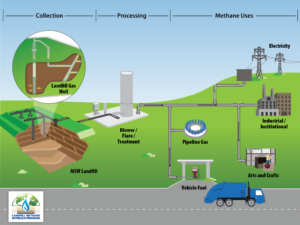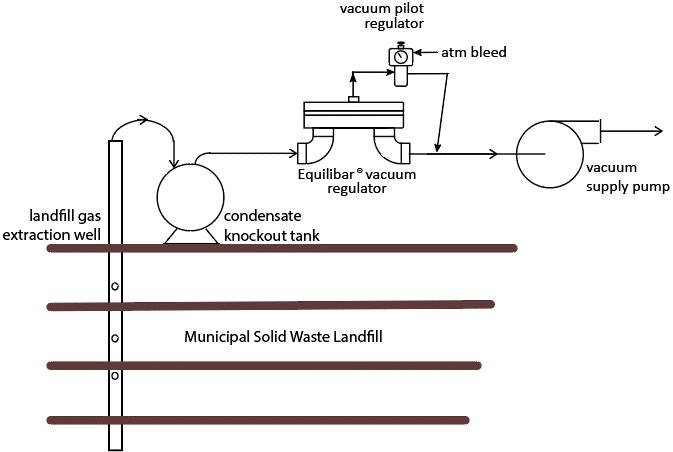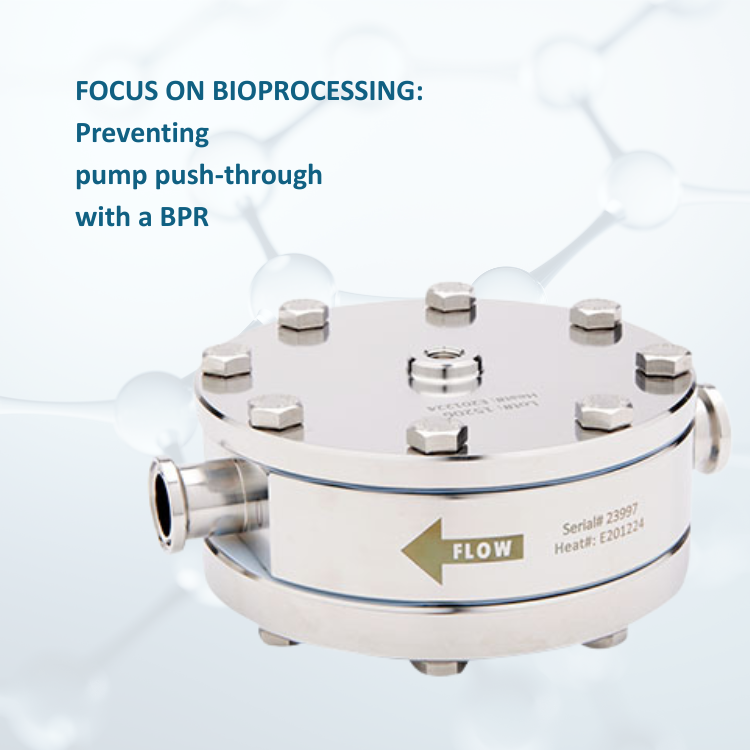Landfills across the world are filled with organic materials that release a mixture of gases as they decompose. This landfill gas (LFG) is roughly equal parts carbon dioxide and methane plus a few minor components. In years past, LFG was often released to the atmosphere or burned off using a flare system.
If the LFG is extracted and processed, however, it can be used as a valuable source of renewable energy instead of being wasted. The methane can be turned into natural gas to power vehicles, heat homes, make electricity and more.
Converting LFG into energy is doubly impactful because it provides a renewable and flexible source of energy without creating new greenhouse emissions.
As the EPA explains :
Municipal solid waste (MSW) landfills are the third-largest source of human-related methane emissions in the United States, accounting for approximately 14.5 percent of these emissions in 2020. The methane emissions from MSW landfills in 2020 were approximately equivalent to the greenhouse gas (GHG) emissions from about 20.3 million passenger vehicles driven for one year or the CO2 emissions from nearly 11.9 million homes’ energy use for one year. At the same time, methane emissions from MSW landfills represent a lost opportunity to capture and use a significant energy resource.
LFG can be extracted throughout the life of the landfill and even after the landfill closes. In fact, LFG can be collected for 20 or more years to create energy without producing new greenhouse gases. As more and more landfills implement LFG extraction, the impact will become even more significant. 
The LFG extraction process
Because LFG is not pure methane, extracting and processing it into a useable form of energy can be complex. For many LFG applications, an important step involves vacuum extraction using vacuum blowers connected to underground vent pipes.
Vacuum systems for LFG extraction must be precisely controlled. For maximum efficiency, the vacuum system is designed to have constant vacuum level at each gas extraction well. Large fluctuations could cause condensate build-up or blockages in the system. The goal is to pull enough vacuum to collect maximum gas from the wells without so much vacuum that oxygen is introduced into the extraction system. A particularly narrow window of vacuum control is required.
An Equilibar® vacuum regulator (EVR) can be used to improve vacuum control in this demanding application because it responds to changes in milliseconds. Control is virtually instantaneous as well as exceptionally precise.
This is possible because the EVR utilizes the same dome-loaded multiple orifice technology as other Equilibar patented fluid control devices. Like Equilibar’s unique back pressure regulator technology, the EVR uses multiple orifices sealed by a flexible diaphragm instead of a single large valve seat. It is dome-loaded by a pilot regulator setting the vacuum setpoint. As flow requirements change, the diaphragm moves a few millimeters to open and close over some or all of the orifices, providing instantaneous and frictionless control. The pilot setpoint pressure may be set with a manual or electronic vacuum pilot regulator.
The EVR can be installed upstream of the vacuum pump to maintain a constant vacuum on the gas collection well regardless of the vacuum source or system pressure. For more details, see the LFG application page.
Related technologies
LFG extraction is closely related to other types of renewable energy that involve biogas made from biomass. Like the organic material in landfills, agricultural waste, manure, food material, municipal waste and other forms of biomass all have the potential to create biogas and other biofuels that can be converted to useful energy. Equilibar products have been used to improve fluid control in many of these processes for more than a decade.
An Equilibar case study from 2010 describes how the Gloversville-Johnstown Waste Water Treatment Plant in New York generates methane from anaerobic digestion of organic matter. This biogas powers 350kW gas powered generators. An Equilibar device was successfully used to control the biogas pressure at 4 psig while circulating excess gas for reuse. Read more here.
In addition, Equilibar devices have played important roles for researchers who are exploring ways to expand biofuel technology. One example is described in an article in the December 2021 issue of Green Chemistry: Elucidation of reaction network and kinetics between cellulose-derived 1,2-propanediol and methanol for one-pot biofuel production – Green Chemistry (RSC Publishing) DOI:10.1039/D1GC03650E.
For more information about the many ways Equilibar fluid control devices can improve LFG applications and other biofuel efforts, please contact one of our application specialists. They look forward to hearing from you.



